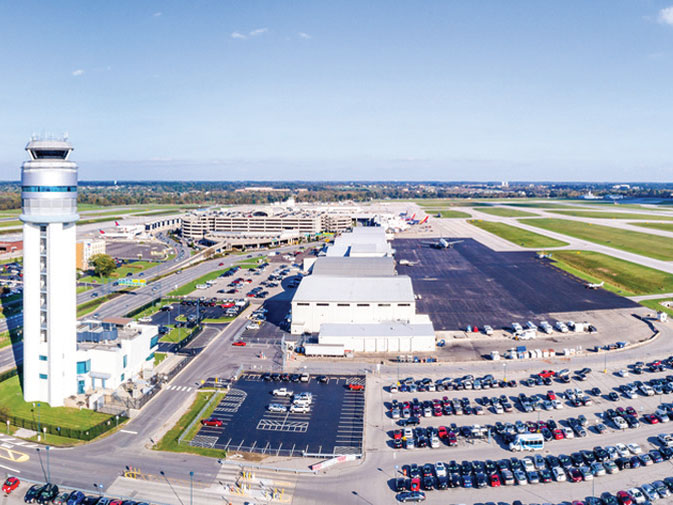The pandemic-fueled supply-chain mess has spurred innovations, including greater use of air cargo, Gulf and Great Lakes ports
The COVID-19 pandemic and its resultant supply-chain crisis has provided an opportunity for shippers and carriers to tweak North American transportation routes. But it’s not as if no one thought about this before. Congestion at the ports of Southern California is nothing new, and some transportation patterns began to change even before the COVID-19 virus was detected on North American shores, especially for cargo destined for the broad midsection of the country.
It makes sense that cargo owners in the U.S. Midwest would prefer that their goods bypass the supply-chain snafus at East and West Coast seaports. Ports on the Gulf of Mexico represent one alternative, and at least one Great Lakes port is also making a play for that cargo.
So are cargo-oriented airports like Rickenbacker International Airport in Columbus, Ohio, which has benefitted from the global trend, in reaction to ocean carrier delays, of increased air cargo volumes. “Before COVID,” said Bryan Schreiber, Rickenbacker’s manager of business development, “we would see maybe 80 or so wide-body international all-cargo arrivals a month. Now we are seeing between 150 and 160 each month.”
The Port of Houston has emerged as an alternative route for some Midwest cargo owners served by Sunset Transportation, a logistics intermediary headquartered in St. Louis. Since late 2019, said its Managing Director Jonathan Falcon, “you’ve seen the Houston market completely change” thanks, in part, to the fact that “there are lots of trucks in Houston.” On the flip side, more trucking capacity drawn to the port has constrained capacity elsewhere in Texas, and freight costs to the Midwest from Houston are up around 50% in the last two years thanks to the increased demand.

APM Terminals to Open Facilities at Plaquemines
A Louisiana port will offer another potential route to the Midwest with the planned development of a container terminal and intermodal rail facility at Plaquemines Port (See Stas Margaronis story on page 18), just south of New Orleans and 50 miles from the Gulf of Mexico. In November, the Plaquemines Port Harbor and Terminal District (PPHTD) announced that APM Terminals will become the operator of the facility, to encompass 1,000 acres and 8,200 feet of Mississippi River frontage. PPHTD, the 13th largest tonnage port in the U.S., covers the first 80 miles of the Mississippi River from the Gulf. (See Stas Margaronis, 12/6/2021 AJOT Insight “New APM Terminals in in Plaquemines Shows Importance of Gulf Ports and Marine Highway”)
The new terminal will provide an “opportunity to write a new supply chain playbook for U.S. exporters and importers,” said Wim Lagaay, CEO of APM Terminals North America. “Importers are looking for more ways to reach major regional consumer markets in the South and Midwest.” The location, added Sandy Sanders, executive director of PPHTD, is nearby “multiple routing options to inland markets.”
One of those options could include container-on vessel services on the Mississippi River from Plaquemines Port, once those planned services come to fruition. “The plan is to schedule three to five vessels per week to different ports along the inland waterway system,” said Mary Lamie, executive vice president of the St. Louis Regional Freightway, a bi-state agency that coordinates regional development in Missouri and Illinois. Studies have shown that routing Midwest freight through Gulf ports and over the river system could reduce transportation costs by 25% to 30%, according to Lamie.
Besides developments at Plaquemines Port, ongoing “advanced discussions” with a potential developer of a proposed port facility in Jefferson County, Missouri, just south of St. Louis, is bringing container-on-vessel service on the Mississippi River “closer to reality,” said Lamie. The St. Louis region is also in the process of improving its local rail infrastructure with the doubling of capacity on the Merchants Bridge, a major east-west connector across the Mississippi River.
An announcement on the Jefferson County development is “expected by the end of the year,” said Lamie. “With the success we’re currently seeing from the various ongoing discussions, we believe the new container-on-vessel service could be launched as early as 2024.”
Great Lakes Connections
On the Great Lakes, the Port of Duluth, Minnesota, is also bidding to handle international container traffic to the Midwest. In October, Duluth completed infrastructure and security investments at the Clure Public Marine Terminal, enabling the handling of containers by direct water connection.
The terminal, located within a Foreign Trade Zone, “is a full-service multimodal logistics hub for the Upper Midwest, so it’s only natural that we offer the advantages of maritime container handling to complement our land-based network” of highway and rail connections, said Deb DeLuca, executive director of the Duluth Seaway Port Authority. “We’ve been nurturing this potential for a while, and we’re excited to see it coming to fruition.
“Considering the significant congestion and delays occurring at some coastal ports,” she added, “we provide a fluid alternative for containers to move inland and bypass those coastal bottlenecks.”
The notion of routing containers to the Midwest by water is not new, noted DeLuca, and has been part of Duluth’s vision for over five decades. “But” she added, “the time is right to bring that vision into a modern focus, and we’re well positioned to do it.”
Although new variants of COVID-19 keep appearing and spreading, and supply-chain uncertainty remains the watchword, the pandemic-fueled supply-chain mess will eventually play out, thanks in no small part to the staying power of the logistics innovations spurred by the crisis. “The silver lining of the pandemic,” said Rickenbacker’s Bryan Schreiber, “is that people are thinking outside the box and looking for different solutions for their supply-chain security and efficiency.”




